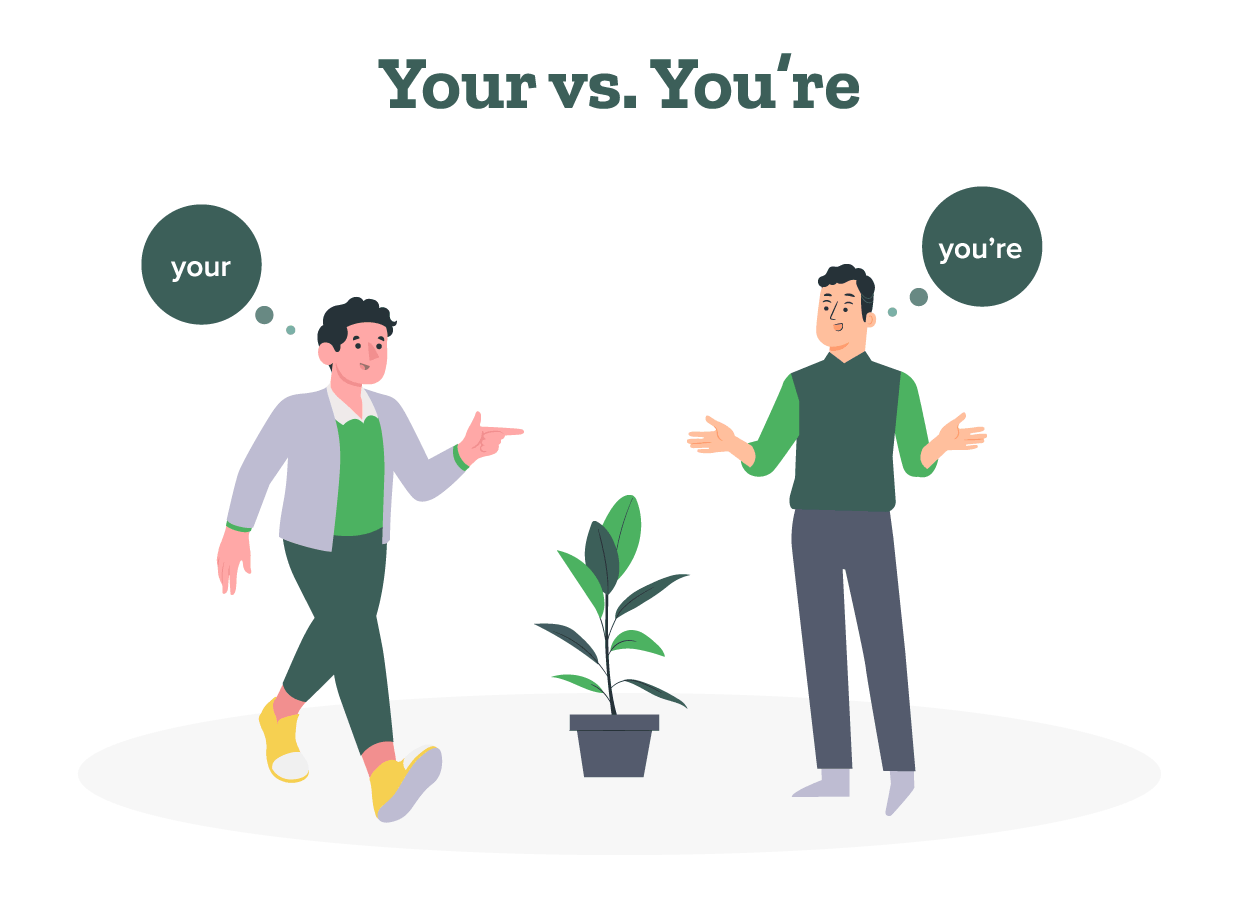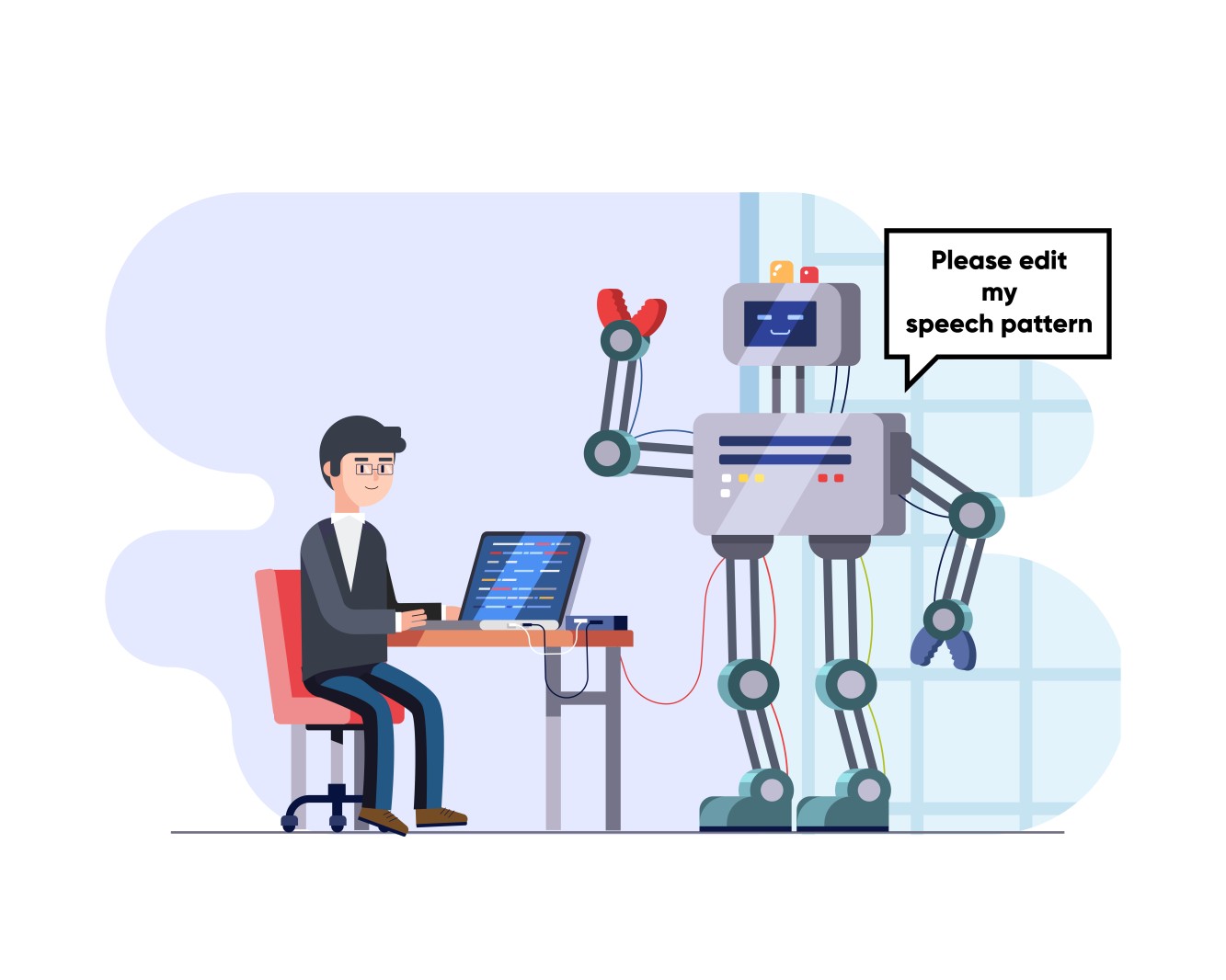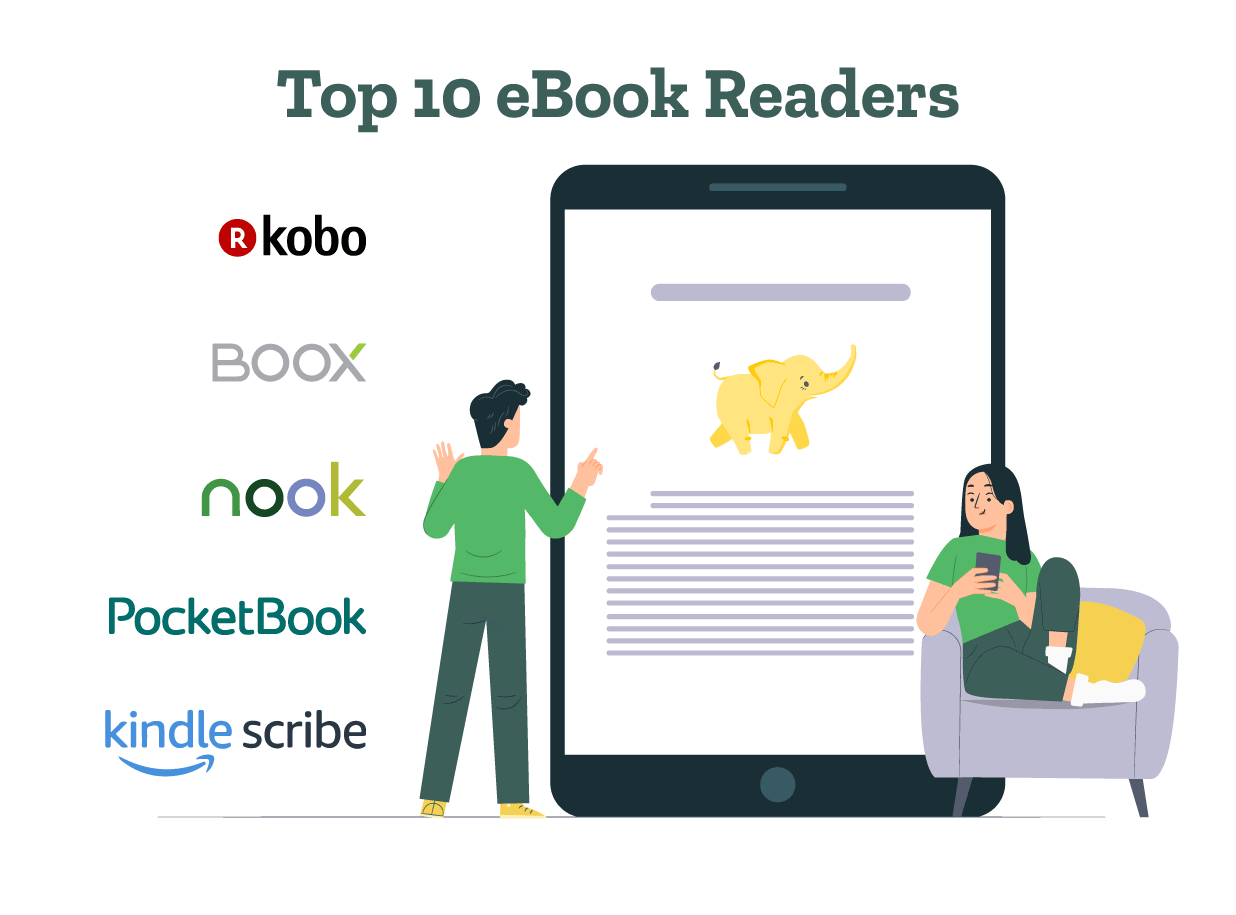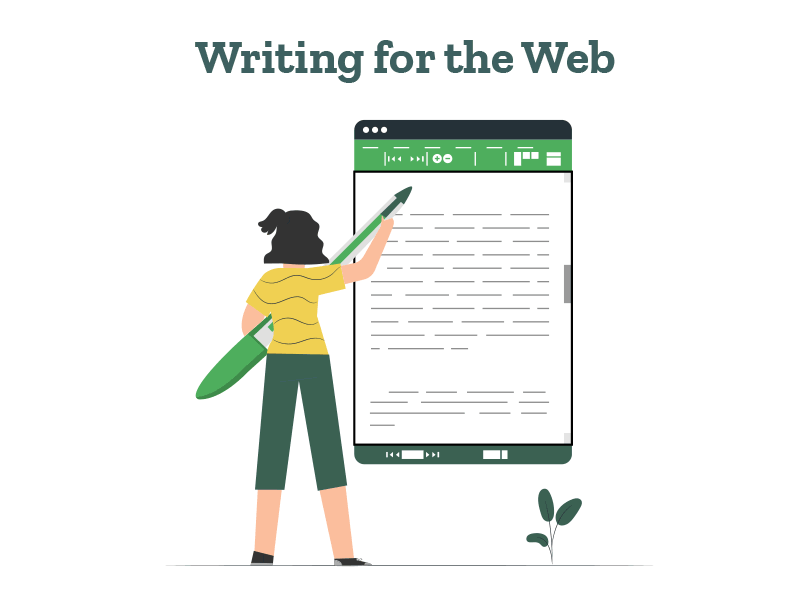Still have questions? Leave a comment

Checklist: Dissertation Proposal
Enter your email id to get the downloadable right in your inbox!
[contact-form-7 id="12425" title="Checklist: Dissertation Proposal"]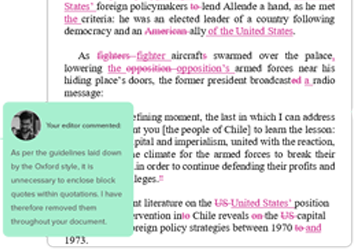
Examples: Edited Papers
Enter your email id to get the downloadable right in your inbox!
[contact-form-7 id="12426" title="Examples: Edited Papers"]Need
Editing and
Proofreading Services?
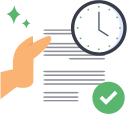
14 Punctuation Marks: A Guide on How to Use with Examples!
 Jun 16, 2025
Jun 16, 2025 8
min read
8
min read
- Tags: Grammar, Punctuation
If you always end up confusing different punctuation marks with each other, you’ve ended up at the right place! Different punctuation styles are used in various writing formats, such as academic, creative, and informal writing.
Our list of punctuation marks will tell you what the 14 punctuation symbols are in English and how to use each one. We’ve added plenty of examples and a free guide so you never have to look for this information again!
It’s best to start with the meaning of punctuation marks. What role do they play in writing, and why are they important? Let’s dive in.
What are punctuation marks?
Punctuation marks are a set of symbols used in writing to separate sentences and phrases in order to indicate pauses, stops, emphasis, and tone. Without punctuation, writing will consist of blocks of text that can’t reflect major aspects of language.
Different languages use different types and numbers of punctuation marks, for various purposes. French, for example, has 17 of them while Arabic only has 6. English has 14 punctuation marks, used to separate or connect elements of grammar, indicate a pause, denote ownership, and more.
In this guide, we will cover the basics of punctuation, including the different types of punctuation marks, their uses, punctuation examples, and how to use them correctly. We will also discuss common punctuation errors and provide tips on how to improve punctuation skills.
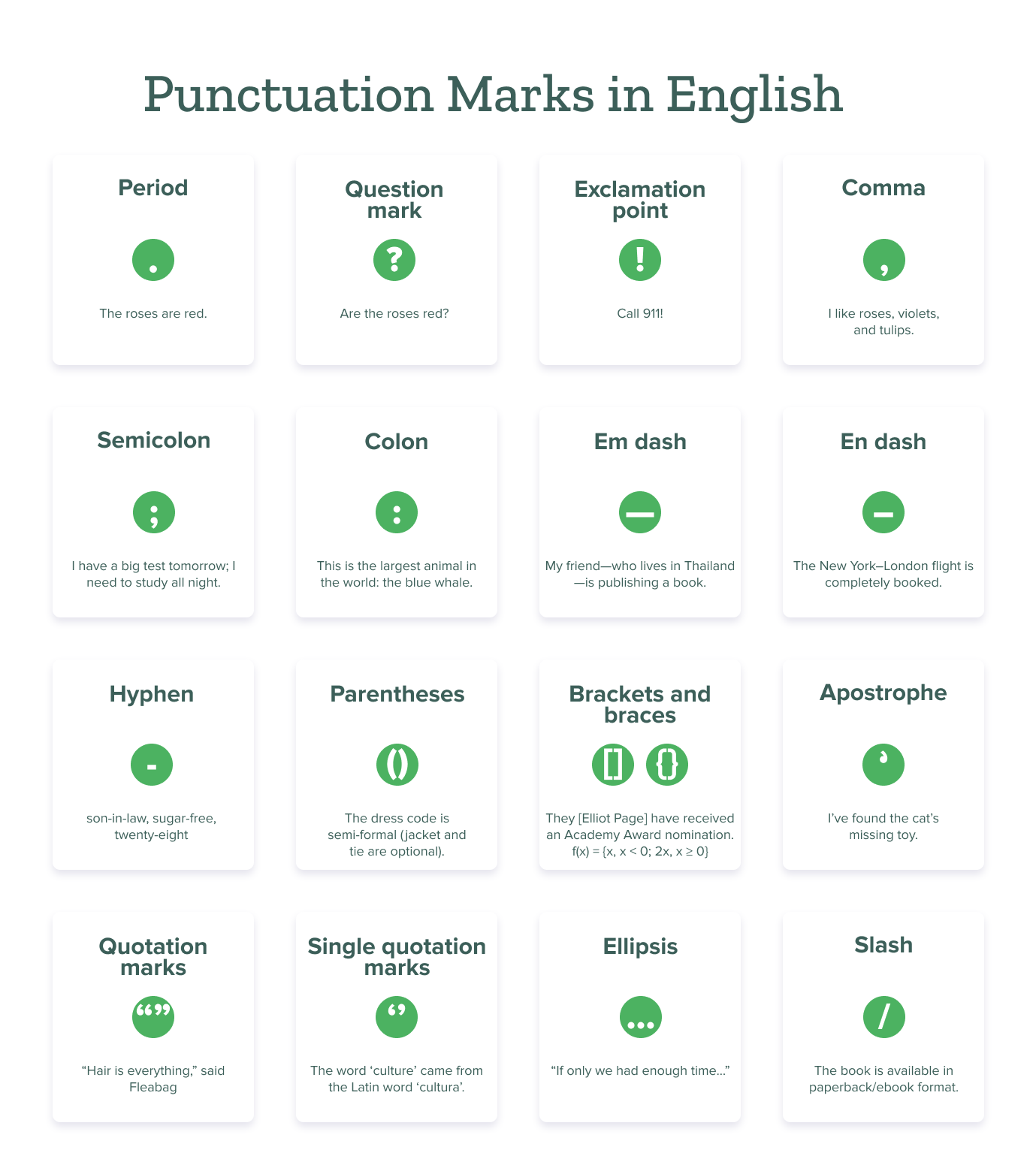
Why are punctuation marks important?
Punctuation marks are important in writing to capture the meaning and flow of spoken language. They help you communicate your thoughts and ideas clearly and create an easy reading experience for your reader. Proper punctuation enhances the clarity and rhythm of written sentences, making them easier to read and understand.
Take a look at this punctuation marks example:
“Can you tell me who wrote ‘The Bell Jar’? I can’t seem to remember,” Jin said. He scratched his head, frowning, making a show of thinking very hard. “Plath,” said May, not looking up from her sketchbook. “The only novel she wrote—published under the pseudonym ‘Victoria Lucas’, though.”
Here’s the same paragraph with no punctuation:
Can you tell me who wrote The Bell Jar I cant seem to remember Jin said He scratched his head frowning making a show of thinking very hard Plath said May not looking up from her sketchbook The only novel she wrote published under the pseudonym Victoria Lucas though
There is no rest for the eye, no pauses or separations, and absolutely no tonal changes. Beginning to see why punctuation is important?
Here are five ways punctuation improves your writing:
- Reduces ambiguity and makes your writing clear.
- Communicates your tone and emphasis effectively.
- Breaks the sentence into smaller chunks, making it easier to read.
- Makes it easier for the reader to trust your authority.
- Prevents misunderstandings and confusion.
Now that we’ve seen the importance of punctuation, let’s understand how to use punctuation marks correctly. We’ve added several punctuation marks examples so you never forget how to use each mark!
What are the 14 punctuation marks?
Here are the 14 punctuation marks in English: the period, question mark, exclamation point, comma, semicolon, colon, dashes, hyphen, parentheses, brackets, apostrophe, quotation marks, ellipsis, and slash.
Some consider the two dashes, en dash and em dash, as separate punctuation symbols. The use of these punctuation marks is quite different, so this characterization isn’t strictly wrong. Some guides also consider braces as more deserving of a place in the punctuation marks list than the slash. However, we’ve considered the 14 punctuation marks most commonly taught in English educational courses around the world.
Ultimately, the characterization is of little importance. It’s much more important to know the use of punctuation marks than how they’re characterized! Let’s dive in.
1. Period (.)
The . is called a period or a full stop. It is most commonly used to end a sentence. That is, all sentences that aren’t direct questions or exclamations! Here are some examples:
The roses are red.
Please close the door.
Violet asked me if she could come to the event. (An indirect question, but written as a statement.)
The second most common use of the period is to denote abbreviations, initialisms, and decimals.
Abbreviation: Dr. Susan and Mr. Ziyuan are headed to the clinic.
Initials: Agents of S.H.I.E.L.D. aired at 8 p.m. yesterday.
Decimal: The value of pi is 3.14.
2. Question mark (?)
The ? is called a question mark. It is most commonly used to ask direct questions.
Are the roses red?
Can you close the door?
Confusion and disbelief:
How is this possible?
Are we sure it’s a power cut?
Questions within quotation marks:
“Can I come to the event?” Violet said.
“Are you ready, Ziyuan?” said Dr. Susan.
Question tags:
The value of pi is 3.14, isn’t it?
You went clubbing last night, didn’t you?
Note: It’s important to consider the tone of the utterance while using question marks. A questioning tone is the best indicator of when to use these punctuation marks and not wh-words.
3. Exclamation point (!)
The ! is called an exclamation point or exclamation mark. You can also call them bangs or shrieks if that suits your fancy! They’re used to show strong emotion, urgency, or an outcry. Exclamation points are crucial for conveying intense emotions and providing clarity in writing.
Here are the ways in which you can use an exclamation point:
Excitement or enthusiasm: How lucky I am to win the lottery!
Surprise or shock: I can’t believe that just happened!
Urgency: Call 911! Hurry, we don’t have much time!
Command: Apprehend him!
Strong emotion: I’m so happy for you!
Exclamations come with a forceful tone and impact, so it’s best to use them in small doses. Otherwise, you can tire your reader with excess excitement!
4. Comma (,)
The , is called a comma. It is used in a number of ways, the most common of which is to separate elements within a sentence. Commas are also used to separate two complete sentences, which are independent clauses.
Serial comma:
Sharon bought needles, string, and ten bolts of fabric for her dress.
Bracketing comma:
Al Pacino, who was born in 1940, is one of the most celebrated actors of all time.
Born in 1940, Al Pacino is one of the most celebrated actors of all time.
Joining comma:
Violet wanted to stay home, but her friends convinced her to go out.
Introductory comma:
On the other hand, some people prefer apples over mangoes.
The comma is also used to separate two adjectives of the same type.
Ibrahim is a kind, caring friend.
In the English language, we also use commas in numbers and dates:
Li Guangli accepted the war treaty with a tribute of 3,000 horses.
The day was Friday, April 28, 2023.
Improper use of commas can lead to errors such as comma splices. Understanding how to connect two complete sentences effectively is crucial to avoiding punctuation errors.
5. Semicolon (;)
The ; is called a semicolon. It is used to connect two independent clauses that are closely related to each other.
The restaurant was too loud; we decided to go elsewhere.
Paramount Pictures didn’t want to cast Al Pacino in The Godfather; the studio was uncertain about casting an unknown actor.
I have a big test tomorrow; I need to study all night.
Semicolons are also used to separate items in a list that already consists of commas.
The menu today is steak with mushrooms, onions, and peppers; grilled salmon with lemon, garlic, and dill; and roasted chicken with potatoes, carrots, and onions.
Kyoto, Japan; Rio de Janeiro, Brazil; and Cusco, Peru are among the most beautiful cities in the world.
6. Colon (:)
The : is called a colon. Mostly, it has one and only one major use: elaborating on whatever precedes it. (See what we did there?)
Colons (:) are punctuation marks primarily used to introduce explanations, lists, or to emphasize points within sentences. They connect related ideas, clarify sentence structure, and improve readability.
You can use this punctuation mark to introduce a list, further explanation, or a quote.
List:
His groceries stumbled out of the paper bag: eggs, bread, cheese, and lots of oranges.
Elaboration:
Anong saw it with complete clarity: She was in danger.
Quotation:
Yeats said it best: “All dreams of the soul end in a beautiful man’s or woman’s body.”
A colon can also help add emphasis on a phrase or word.
There is one creature larger than any other animal on the planet: the blue whale.
When using a colon, always capitalize the first word if—and only if—the following element is a complete sentence.
Less commonly, we also use the colon in the following instances:
Subtitle: The Beam: Part One
Time: 05:05 a.m.
7. Dashes (—/–)
There are two types of dashes in the English language: em dash and en dash. They are horizontal lines slightly longer than a hyphen and are mainly found in typeset documents.
Em dash (—)
The — is called the em dash, and it is the longer of the two dashes. The em dash is used to provide additional information and indicate an interruption or an emphasis.
Additional information:
My friend—the one who lives in Thailand—is publishing a book.
Interruption:
“I’m so glad we finally met—”
“Truly! This was such a great evening!”
Emphasis:
It’s time to study the most intriguing of all astrological bodies—black holes.
En dash (–)
The – is called an en dash, and it is the shorter of the two dashes. It indicates a range of values or a connection between two grammatical units.
Indicating a range:
The decade 2010–2020 was a time of great technological advancements.
Connecting two units:
The New York–London flight is completely booked.
Showing conflict or opposition:
The Lakers–Celtics rivalry is well-known in the sports world.
Note: Unless your style guidelines recommend it, never use spaces with dashes. Aside from some rare instances (01 January 2023 – 31 December 2023), using spaces with the en dash is never permitted.
8. Hyphen (-)
The – is called a hyphen. Shorter than both dashes, it is most commonly used to join words or parts of words. A hyphen is specifically used in the creation of compound words, connecting two or more words to form a single term.
Compound words:
son-in-law, lo-fi, five-year-old
Prefixes and suffixes:
cross-check, self-assured, all-expenses, goth-style, sugar-free, mayor-elect
Numbers:
twenty-eight, forty-ninth
Pauses:
The spelling of pheromones is p-h-e-r-o-m-o-n-e-s.
Why is it so c-c-cold in here?
It is important to distinguish hyphens from dashes, as confusing them can lead to common punctuation errors.
9. Parentheses ()
The ( ) are called parentheses. They enclose additional information that isn’t strictly necessary in the sentence but provides context.
Clarification:
The company’s profits have increased by 20% (largely due to their new marketing campaign).
Abbreviation:
The World Health Organization (WHO) has substantiated this information.
Alternatives:
The dress code for the party is semi-formal (jacket and tie are optional).
Emphasis:
I can’t believe she said that (of all things) in front of the new joinee.
10. Brackets [] and braces {}
The [] are called brackets, and along with braces {}, they are known as bracket braces. Brackets are mostly used to clarify the meaning of a sentence, while braces are often used for grouping or organizing content, especially in technical writing.
They [Elliot Page] have received an Academy Award nomination.
Shanice knew it [the ship] had come from another world.
You’ll find brackets more commonly in academic writing, where authors use them to clarify quotes.
According to Bronkovich, “The president [was] expected to resign soon.”
In the above quote, square brackets are used to change the verb tense. In this manner, brackets can help an author modify the original statement for better clarity and understanding by their readers.
Academic writing also uses brackets to add parentheses inside parentheses, called nesting parentheses.
The study (conducted by researchers from Harvard University [Cambridge, MA] and Oxford University [Oxford, UK]) found that exercise can reduce the risk of heart disease.
11. Apostrophe (’)
The ’ is called an apostrophe. It is a punctuation mark used to indicate possession or to show that some letters have been omitted from a word.
Possession
My cat’s toy has gotten old.
The fight for women’s rights is a fight for human rights.
The boys’ dormitory is that way.
Contraction
Apostrophes are used in contractions to show where one or more letters have been omitted.
I have: I’ve
Do not: Don’t
They are: They’re
Plural for letters and numbers
Make sure to dot your i’s and cross your t’s!
How many 10s are there in this deck?
12. Quotation marks (“”/‘’)
The “” are called quotation marks, or more specifically, double quotation marks. They’re most commonly used to indicate dialogue writing in fiction. In American English, commas and periods are always placed inside quotation marks.
“Hair is everything,” said Fleabag.
“My good opinion,” said Mr. Darcy, “once lost, is lost forever.”
“That is a failing indeed!” cried Elizabeth. “Implacable resentment is a shade in a character.”
Quotes:
Mulaney (2019) observed that “the unexpected finding of pitting corrosion in Alloy B warrants further investigation”.
Titles:
“A Temporary Matter” is the first short story in Interpreter of Maladies.
Maya Angelou wrote “And Still I Rise” in 1978.
Single quotation marks (‘’)
The ‘’ are called single quotation marks. They are used to indicate a quotation within a quotation or to highlight a word or phrase being discussed.
Quote within a quote:
“It’s like Emeze said, ‘Some people can’t see softness without wanting to hurt it.’”
Highlighting words or phrases:
The word ‘culture’ came from the Latin word ‘cultura’, which means ‘cultivation or growing’.
Single quotation marks are more widely used in British English. While American English favors double quotation marks, British English favors single quotes.
13. Ellipsis
The … is called an ellipsis. This punctuation mark is used to indicate the omission of a word, phrase, or sentence in a quotation or to create a pause, trailing-off speech, or unfinished thought in both formal and informal writing.
Omission:
“Musicians still find inspiration in the Beatles’ songs…allusions to their work and lives can be found almost everywhere.” (Malek 37)
Pause or trailing off:
“I never said that… did I?”
“I was thinking that maybe we could… well, never mind.”
“If only we had enough time…”
14. Slash (/)
The / is called a slash. It is used to represent a number of different things, including division, fractions, and options.
Options: The book is available in paperback/ebook formats.
Fraction: ⅔ of the Earth is covered in water.
Division: It’s simple math; 24/3 equals 8.
Common Errors with Punctuation Marks
Comma Splices
One of the most frequent mistakes is joining two complete sentences with just a comma. For example: “I love writing, it’s my passion” should be “I love writing; it’s my passion” or “I love writing. It’s my passion.”
Apostrophe Confusion
Writers often mix up “it’s” (it is) with “its” (possessive), or add apostrophes to plural nouns. Remember: apostrophes show possession or contractions, not plurals. “The dog’s toy” is correct, but “The dog’s are barking” is wrong.
Misplaced Semicolons
Semicolons connect two related independent clauses, not fragments. “I write every day; because practice matters” is incorrect. The correct version is “I write every day; practice matters” or “I write every day because practice matters.”
Quotation Mark Placement
In American English, periods and commas go inside quotation marks: “I love this story,” she said. Question marks and exclamation points only go inside if they’re part of the quoted material.
Hyphen vs. Dash Confusion
Hyphens (-) connect compound words (well-known author), en dashes (–) show ranges (pages 10–15), and em dashes (—) create dramatic pauses or set off information—like this.
With the slash, our list of punctuation marks and symbols comes to an end. As providers of editing services, we realize the importance of using correct grammar while communicating. Want to keep reading about language, grammar, and writing? Here are some useful resources:



